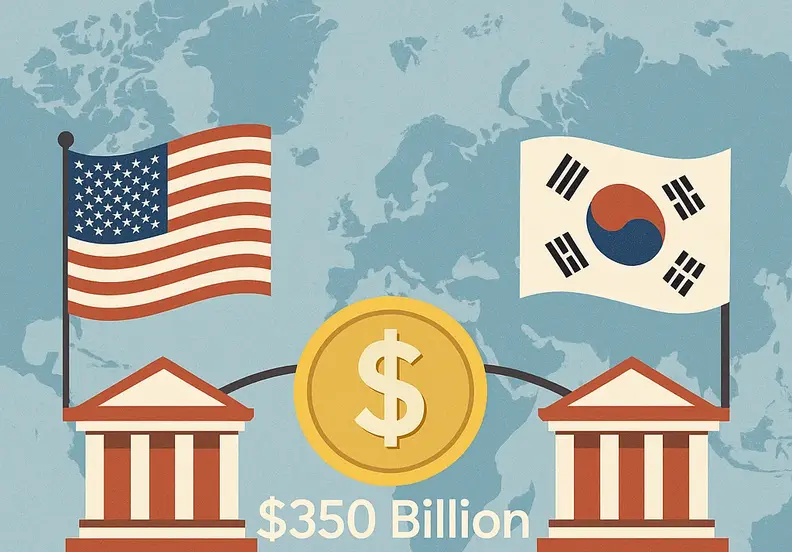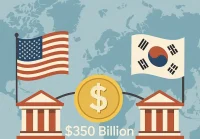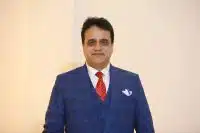The United States and South Korea are currently focused on structuring a massive $350 billion investment deal, with negotiations centering on payment mechanisms rather than traditional currency swap arrangements. The complexity of this deal stems from Korea’s foreign exchange market constraints and the need to balance commercial viability with strategic partnership requirements.
The Payment Challenge: $20 Billion Annual Limit
The Bank of Korea Governor Rhee Chang-yong has stated that the maximum amount Korea can raise in dollars annually without market disruptions is $20 billion. This creates a significant challenge for a $350 billion deal, as it would take 17.5 years to raise the full amount at this pace.
Regarding upfront payments, the Bank of Korea is keeping various possibilities open for the foreign exchange market and is currently in negotiations with the United States. However, due to the current state of Korea’s foreign exchange market, they cannot pay up front. US Treasury Secretary Bessant has understood this constraint and is having internal discussions on how to respond to the situation.
The Currency Swap Question: Conditional, Not Guaranteed
There has been much discussion about a potential currency swap agreement, but this is not a guaranteed component of the deal. Whether a currency swap is needed and to what extent will depend entirely on how the deal is structured. It may not be necessary at all, or it could be arranged on a smaller scale.
The currency swap itself is a necessary condition, not a sufficient one. Depending on how this deal turns out, Korea plans to consult with the US regarding the currency swap aspect as well. Even if there is a currency swap, it will be difficult to blindly provide money to the US without considering the commercial rationality or viability of the project being selected.
The Argentina Comparison: Different Circumstances
When asked about structuring something similar to the Argentina-style arrangement going through the Treasury instead of directly from the Fed, the response was clear: Korea’s situation is different. Korea is not doing this because they lack short-term foreign reserves like Argentina or Hungary.
Instead, it’s a situation where Korea needs foreign currency to make long-term investments as requested by the US. Therefore, the US must provide the lacking foreign currency. This doesn’t align with the conventional short-term currency swap structure, and if Korea were to engage in a currency swap arrangement with the US, there are further points that require discussions.
The Won Depreciation: Market Concerns Over Tariffs
The South Korean won has reached 1400 per dollar, raising questions about whether this reflects fundamentals or market concerns. Much of the recent depreciation reflects market concern that the tariff negotiations haven’t been finalized. Korea is currently pursuing negotiations with the US within a range that doesn’t significantly impact Korea’s foreign exchange market.
Fortunately, US Treasury Secretary Bessant is fully aware of the situation in Korea’s foreign exchange market. Therefore, once the issue is resolved, that uncertainty will likely fade, potentially leading to won appreciation.
The Automotive Sector Impact: Higher Tariffs Than Competitors
South Korean automakers are facing significant challenges because the tariffs continue to be much higher than for Japan and Europe, who already have the US tariffs lifted. The government is providing all possible policy support to automakers and auto parts companies facing difficulties due to these higher tariffs compared to the EU and Japan.
Korea believes that if these negotiations yield some breakthrough, those issues could also be resolved. The ongoing trade negotiations are crucial for maintaining Korea’s competitive position in the US market.
The FTA Advantage: Korea’s 2.5% Edge at Risk
Korea had a free trade agreement with the US, giving it an advantage of around 2.5% over competitors. This advantage is being discussed in the ongoing trade negotiations, as Korea would lose its advantage over Japan before the trade deal is finalized.
Korea has conveyed this point to President Trump and explained to Bessant and Lutnick that since Korea is an FTA partner, tariffs on Korea are already sufficiently low. But tariffs on other countries aren’t sufficiently low, making it unfair. Even so, it seems the US isn’t very willing to understand that aspect, and Korea plans to continue explaining and persuading them.
The Stock Market Boom: AI Exuberance or Bubble Concerns
Because of the exuberance around artificial intelligence, South Korea’s stock market is on a tear. However, the current stock market reflects expectations for the Korean economy, such as enhancing shareholder value in the Korean capital market, expanding dividends, or resolving unfair practices.
Expectations for the modernization of the Korean stock market are driving the current performance. On top of these expectations, Korea is actively supporting the core technology economy to ensure a robust Korean economy that can be a global investment destination.
AI Growth Needs Real Talent Behind It
The Korean AI boom shows how fast markets move when innovation meets momentum. Whether you’re scaling an AI startup or building an enterprise data team, real performance depends on the people who can turn optimism into execution. Hire engineers, analysts, and AI specialists ready to deliver measurable results.
Build Your AI Workforce →The Negotiation Complexity: Balancing Multiple Factors
The $350 billion deal negotiations are complex because they must balance multiple factors: Korea’s foreign exchange market constraints, the need for commercial viability, strategic partnership requirements, and the impact on various sectors of the Korean economy.
The US Investment fund has been very difficult to agree on the details, and Secretary Bessant has been told about the feasibility of having so much cash upfront. The negotiations are currently underway with the US, but specific details on the plan cannot yet be provided.
The Strategic Implications: Long-Term Partnership
This deal represents more than just a financial transaction—it’s about strengthening the strategic partnership between the US and Korea. The negotiations are taking into account the potential financial shocks to South Korea and the need to maintain economic stability while pursuing strategic objectives.
The US must provide the lacking foreign currency that Korea needs for long-term investments, but this must be done in a way that doesn’t destabilize Korea’s foreign exchange market or create unsustainable financial burdens.
The Bottom Line: A Work in Progress
The US-Korea $350 billion deal negotiations are a work in progress, with both sides working to find a structure that accommodates Korea’s foreign exchange market constraints while meeting the strategic objectives of both countries. The focus on payment structure rather than traditional currency swaps reflects the unique nature of this arrangement.
The success of these negotiations will depend on finding creative solutions that allow Korea to participate in the deal without disrupting its foreign exchange market, while ensuring that the US receives the strategic benefits it seeks from the partnership.
FAQ Section
Q: Why can’t Korea pay the $350 billion upfront?
A: Korea can only raise a maximum of $20 billion annually without disrupting its foreign exchange market, making upfront payment of $350 billion impossible without causing significant economic instability.
Q: Is a currency swap still on the table?
A: Whether a currency swap is needed depends entirely on how the deal is structured. It may not be necessary at all, or it could be arranged on a smaller scale, but it’s not a guaranteed component.
Q: How is this different from the Argentina deal?
A: Korea’s situation is different because they don’t lack short-term foreign reserves like Argentina. Instead, Korea needs foreign currency for long-term investments, requiring the US to provide the lacking foreign currency.
Q: What’s causing the won depreciation?
A: Much of the recent won depreciation reflects market concern that the tariff negotiations haven’t been finalized. Once the issue is resolved, that uncertainty will likely fade.
The Path Forward: Creative Solutions Required
The US-Korea $350 billion deal negotiations require creative solutions that balance Korea’s foreign exchange market constraints with the strategic objectives of both countries. The focus on payment structure rather than traditional currency swaps reflects the unique nature of this arrangement and the need to find sustainable financing mechanisms.
The success of these negotiations will determine not just the financial terms of the deal, but the future of the strategic partnership between the US and Korea in an increasingly complex global economic environment.




